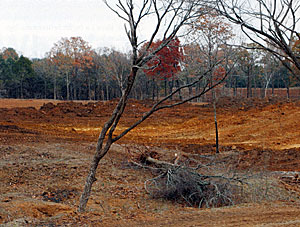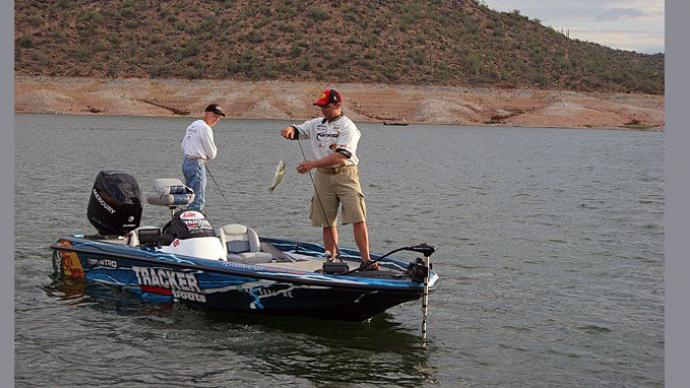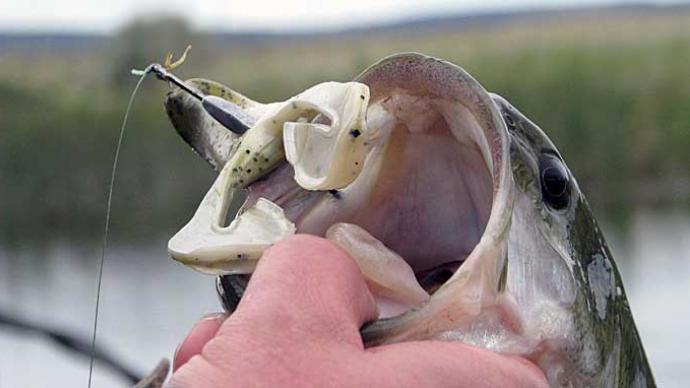
Part of the talk of today's pond management is about adding fish attractors to fishing lakes and ponds. People are truly learning about the value of habitat improvement. But, there seems to be some confusion about semantics and describing different elements of habitat. Most pond owners want to add attractors, but before we can even discuss attractors, a pond manager should understand the words structure and cover.
Structure is defined as the shape of the bottom of a lake - the permanent features. It's the gradual, the more rapid, and near vertical changes in depth. It's the humps, the old river or creek bottoms and edges, the underwater bars, underwater points, and bluffs. These depth changes are identifiable on any underwater contour map, and tend to form the underwater highways, and feeding and breeding flats used by fish.
Some ponds and lakes have lots of structure. Others, little dish-bowls with dams, have very little. Little structure means little bottom information about where fish are likely to feed, travel, hold, and breed. Thus, understanding structure is key to anticipating fish positions during feeding, spawning, and inactivity— when they are suspended or otherwise holding tight. Increased structural diversity is beneficial as it provides more usable habitat and likely feeding areas, thus increasing the overall productivity of ponds and lakes. We all seem to strive for better productivity.
Cover is just what its name implies; it provides cover, typically for smaller prey. Cover protects prey from larger predators, especially adult bass, crappie, and larger catfish, or in northern waters, smallmouth bass. Small, non-pelagic prey, such as bluegill, prefers to hide in cover and live most of their lives near cover so as to readily escape being eaten. While pelagic fish such as threadfin shad live mostly in open water, shad will come to shoreline cover to spawn and sometimes to seek food available on surfaces of cover objects.
Cover is also home and protection of most insect larvae, invertebrates, and other tiny foods small fish must have to eat. Abundant cover, particularly along shorelines, is necessary to maximize the food chain, and thus maximize pond and lake productivity. Aquatic vegetation can be categorized as cover.

Larger game fish are attracted to, and hunt near, cover—because that's where the non- pelagic prey is usually found. How many times have you thrown a spinnerbait along the edge of aquatic plants, knowing you'll hook into a nice fish?
When pond managers insert cover, they insert objects to protect and attract prey, and thus also attract larger fish. Unfortunately, the use of the term fish attractors tends to obscure the importance of cover to productivity. Cover placed in ponds has two functions: to provide a safe haven for small fish, and to provide a good source of food for those small fish. If objects are only seen as attractors, managers will miss many opportunities to improve their waters.
Studies have shown underwater brush, piles of old wood, bricks, rocks, tires, man-made-cover, and practically any old thing may create fish attractors that will help anglers catch fish. I've fished a pond in which a few sunken and rusty shopping carts were cast-to objects.
There is also considerable scientific research indicating that increased cover and shoreline woody debris are associated with increased fish production, which leads to increased catches. Even more research shows cover objects attract and hold predators, making it easier for anglers to locate and catch them. But although artificial cover sometimes works, many inserts don't, and pond owners should wonder why.
All places where attractors may be positioned are not equal, and different types of brush and underwater structures attract fish differently. Understanding the whys of placement, and what different materials do, can help.
Areas already containing adequate underwater and shoreline vegetation, brush, woody debris, or other cover items are difficult to improve by adding additional cover. Attractors should be placed in spots that are essentially devoid of cover, but still are transited by sufficiently large numbers of bluegills, crappie, catfish, or black bass. Good spots are locations on relatively barren ridges or points leading to shores used by fish during the spawn, near frequently used shoreline feeding areas, or on underwater pathways that lead between areas already known to hold ample fish.
Depth is an important variable. Shoreline cover should protect the smallest prey from larger predators, offer a few potential ambush points to predators, or protect fish nests from nest raiders.
Some deeper cover should offer hiding places to smaller fish at times when shallows are too warm, or in late fall and winter. Deeper cover may also attract crayfish as potential prey. Other deep cover simply offers larger fish places to rest while inactive. In larger ponds and lakes, those with pelagic prey fish like threadfin shad, deep piles of cover may offer predators safe-areas from which to range out into more open water in search of shad schools.

Large, individual brush piles or attractors work, but lines of cover objects often work even better. When placed along a natural route like a ditch or old creek bed between deep water and a feeding flat, cover gives migrants places to stop, rest, perhaps feed, and then move on.
A line of cover like a fence running from the shoreline to deep water can also be important. Actively feeding bass tend to cruise at constant depths, pausing to inspect cover they encounter enroute for catchable prey. Cover items which bisect these cruising routes make good targets for anglers. If natural pathways into the shallows are limited, as in a bowl-like pond, lines of cover perpendicular to the shoreline may facilitate seasonal migrations and shorter daily depth changes in and out of the shallows.
If placed parallel along a depth contour line, cover will be visited by patrolling bass holding at that depth. As some lunker bass seem to prefer to be in the 6-10 foot depth range, objects placed at that depth can become productive casting targets.
What about cover for nesting fish? Black bass, crappie, and most sunfishes prefer to spawn on hard bottoms. Substrates like sand and gravel are preferred over thick mud. Unfortunately, ponds and old man-made lakes tend to silt-in. This often makes placement of spawning attractors desirable. For most waters, spawning attractors should be placed no deeper than the depth reached by direct sunlight in spring months.
Crappie and sunfish are more adaptable than bass at selecting and using mucky or weedy spawning sites. But, if pond muck is limiting spawning, a manager may need to artificially create larger areas of hard surface by laying in pebble/sand flat areas or placing a number of slabs flat on the bottom. These fishes tend to spawn in groups with multiple nests offering protection so they do not need adjacent hard vertical materials.
Bass spawning attractors are different from other shoreline cover. Spawners like having some solid object like a bulwark wall or horizontal log that blocks approach to their nesting site from one or more directions. A spawning attractor should have a solid side, offering little cover through which a small nest predator can approach. Brush piles are poor for this purpose. If the bottom is heavily silted, the attractor needs a large slab rock or brick floor to provide a desirable horizontal surface adjacent to the solid object.
Pond management is fun. Successful pond management is even more fun. Understanding the differences between structure and cover will help you become a better manager. Understanding the roles of cover for different sizes of different species of fish will help you manage your waters to become much more productive.
Reprinted with permission from Pond Boss Magazine




